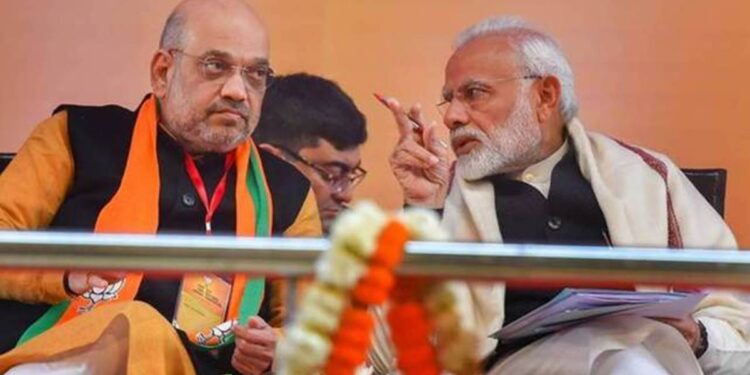The Bharatiya Janata Party suffered a major setback on Saturday as the Congress trounced its way to victory in a state the saffron party sees as its political gateway to southern India. As of leads and results available at 7 PM, Congress has bagged 136 seats against 64 for the BJP.
The defeat comes just months after the party lost power to Congress in Himachal Pradesh and ahead of a set of crucial elections in the Hindi heartland states of Madhya Pradesh, Chhattisgarh and Rajasthan to be held along with Telangana in November-December this year. The development also comes as a setback for the party which is looking to expand its footprint in southern states ahead of the Lok Sabha elections less than a year from now.
The defeat would pinch the BJP even more as it comes despite an aggressive campaign by Prime Minister Narendra Modi. With the leadership of Chief Minister Basavaraj Bommai coming under question from the Opposition and insiders alike, the BJP had pinned its hopes on the PM’s charisma and connect with voters to sail through.
Sadly for the BJP, PM Modi’s last-leg campaign blitzkrieg and even desperate attempts to pull the BJP out of the depths it sank to proved insufficient. While many could already see the BJP’s defeat a mile away — the state has never voted an incumbent back to power in three decades — the credit must go to Congress where it’s due.
BJP’s Own Doing
Much of the failure of the BJP must be attributed to its own doing. And no, it’s not about the ticket selection. Things began to go on a downward spiral much earlier. The ‘corruption’ tag that the Basavaraj Bommai-led BJP had earned in Karnataka set this election apart from the rest, even in states where it lost.
It failed to regain control of the narrative when an alleged audio clip of a BJP minister — stating that the BJP government was “managing things” till 2023 — went viral, and again when the “40% commission sarkar” barb was thrown at it. Due to the apparent inaction by the Chief Minister in handling these issues, voters and the party cadre associated a sense of helplessness, even incompetence, with their top leader.
CM Bommai’s inability to take remedial measures when contractor Santosh Patil who accused former minister KS Eshwarappa of corruption, was found dead in April last year, also dented the BJP’s image badly.
Congress: Vocal for Local
On the other hand, the Congress managed to successfully run a coordinated campaign targeting the inadequacies of the BJP government in the state. Despite the presence of its entire central leadership which crisscrossed through the state, the party, on most occasions, managed to keep its speeches limited to issues pertaining to Karnataka.
Party leader Rahul Gandhi, for instance, refrained from launching his pet “Adani-Ambani” attack against Prime Minister Narendra Modi. His sister Priyanka Gandhi Vadra did not invoke Rahul’s disqualification as an MP. UPA chairperson Sonia Gandhi too only made a veiled reference to issues affecting the country but focussed more on the impact of the Bharat Jodo Yatra and her own connection with the state. The course correction by party president Mallikarjun Kharge, perhaps the only leader who veered from the set path with his “poisonous snake” remark against the Prime Minister, also did not take long.
There were several provocations along the way — the row over its promise to act against organisations like Bajrang Dal and the proposal to reverse the revocation of the 4 per cent Muslim quota — but Congress remained headstrong and largely stuck to local issues. This is largely attributable to the clear understanding within the party’s state leadership — particularly KPCC president DK Shivakumar — that the campaign must not divert to national issues, especially not PM Modi.
The Caste Gambit
There have been ample voices that suggest that the BJP’s state unit had ignored the distress signs emanating from the ground in Karnataka. Issues meant to polarise voters along religious lines — Hijab and Tipu Sultan to name a few– were failing to make the impact that the BJP had hoped. The quota rejig, less about wooing the Lingayats and Vokkaligas, and more about trying to polarise voters, came as too little too late.
The Dalits, which had voted heavily for the BJP in 2018 shifted their loyalties to the Congress. As did a large section of Vokkaligas due to inadequate representation in the candidates list. The Kurubas were already solidly behind Siddaramaiah and the apparent sidelining of party veteran BS Yediyurappa led to disenchantment among a large section of the Lingayats. The open infighting that surfaced after ticket distribution only dented BJP’s already fragile image further.
The Labharthi Disenchantment
In many ways, there was nothing going for the BJP at any point in the months leading up to the elections. Even women, who have solidly backed the BJP in several states where it is in power, also appear to have drifted away from the party. Reports suggest that the execution of central schemes crumbled in light of weak and ineffective leadership.
In contrast, the Congress’ clear messaging on its five promises of Yuva Nidhi, Anna Bhagya, Gruha Jyothi, Uchita Prayana and Gruha Lakshmi struck a chord with voters. As the BJP heads into a year that will be full of challenges, the leadership has much to ponder over.
Arrogance coupled with an inability to nurture state-level leadership can be more dangerous than BJP would imagine. The ‘Double Engine’ has derailed in Karnataka and the BJP may be swiftly losing its halo of invincibility in states. It’s time Narendra Modi makes amends.















